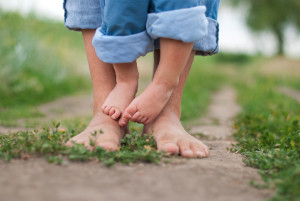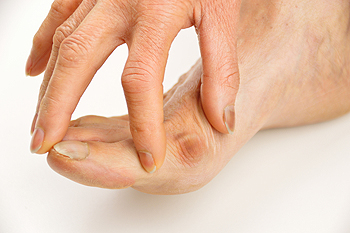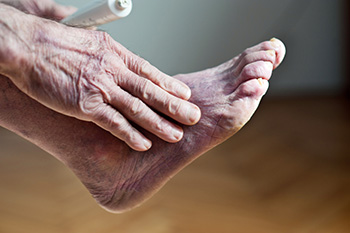
Morton’s neuroma is a painful condition that involves thickening of the tissue surrounding a nerve in the ball of the foot, often between the third and fourth toes. This can cause sharp pain that feels like something is stuck in the shoe. Other symptoms are burning, numbness, or tingling. Causes include repetitive pressure on the forefoot, wearing tight shoes, high heels, or having certain foot shapes that place added stress on the nerve. Symptoms may worsen with walking or standing for long periods. A podiatrist can assess the foot, provide proper footwear guidance, prescribe custom orthotics, and recommend treatments that reduce nerve irritation and improve comfort. If you have pain in this part of your foot, it is suggested that you consult a podiatrist who can offer effective relief and treatment solutions.
Morton’s neuroma is a very uncomfortable condition to live with. If you think you have Morton’s neuroma, contact David K. Morris, DPM of Florida. Our doctor will attend to all of your foot care needs and answer any of your related questions.
Morton’s Neuroma
Morton's neuroma is a painful foot condition that commonly affects the areas between the second and third or third and fourth toe, although other areas of the foot are also susceptible. Morton’s neuroma is caused by an inflamed nerve in the foot that is being squeezed and aggravated by surrounding bones.
What Increases the Chances of Having Morton’s Neuroma?
- Ill-fitting high heels or shoes that add pressure to the toe or foot
- Jogging, running or any sport that involves constant impact to the foot
- Flat feet, bunions, and any other foot deformities
Morton’s neuroma is a very treatable condition. Orthotics and shoe inserts can often be used to alleviate the pain on the forefront of the feet. In more severe cases, corticosteroids can also be prescribed. In order to figure out the best treatment for your neuroma, it’s recommended to seek the care of a podiatrist who can diagnose your condition and provide different treatment options.
If you have any questions, please feel free to contact our office located in Plantation, FL . We offer the newest diagnostic and treatment technologies for all your foot care needs.

Children’s feet go through constant change as they grow, developing from soft, flexible structures into strong, supportive foundations. In infancy and early childhood, the bones are still forming, and the arch is not yet visible because of natural fat padding. As kids become more active and start walking, running, and jumping, the muscles and ligaments strengthen, and the arches begin to take shape. Proper-fitting shoes are essential during these stages, as tight or poorly shaped footwear can interfere with normal development. Flat feet, in-turning toes, or uneven walking patterns are common early on, but should be monitored to ensure they improve with growth. Regular foot checks by a podiatrist help identify any concerns before they cause discomfort or affect mobility. If you notice that your child seems to be experiencing foot discomfort, unusual wear on your child’s shoes, or frequent tripping, it is suggested that you schedule a podiatric evaluation.
Making sure that your children maintain good foot health is very important as they grow. If you have any questions, contact David K. Morris, DPM of Florida. Our doctor can provide the care you need to keep you pain-free and on your feet.
Keeping Children's Feet Healthy
Having healthy feet during childhood can help prevent medical problems later in life, namely in the back and legs. As children grow, their feet require different types of care. Here are some things to consider...
Although babies do not walk yet, it is still very important to take care of their feet.
Avoid putting tight shoes or socks on his or her feet.
Allow the baby to stretch and kick his or her feet to feel comfortable.
As a toddler, kids are now on the move and begin to develop differently. At this age, toddlers are getting a feel for walking, so don’t be alarmed if your toddler is unsteady or ‘walks funny’.
As your child gets older, it is important to teach them how to take care of their feet.
Show them proper hygiene to prevent infections such as fungus.
Be watchful for any pain or injury.
Have all injuries checked by a doctor as soon as possible.
Comfortable, protective shoes should always be worn, especially at play.
If you have any questions, please feel free to contact our office located in Plantation, FL . We offer the newest diagnostic and treatment technologies for all your foot care needs.

When the big toe starts to angle toward the smaller toes, a bony bump can form at its base, often leading to pain, redness, and swelling. Bunions tend to worsen over time and are commonly linked to inherited foot structure, tight shoes, or repeated stress on the forefoot. As the joint becomes irritated, even walking short distances may feel uncomfortable. Comfort-focused changes can help reduce strain and relieve pressure. Supportive shoes with roomy toe boxes, soft padding, and custom orthotics can make a noticeable difference. Applying cold packs and doing gentle toe exercises may also ease soreness. In some cases, professional treatment is needed to correct alignment or reduce inflammation. If your foot pain or joint swelling continues to interfere with daily activities, it is suggested that you consult a podiatrist for expert evaluation and a personalized care plan.
If you are suffering from bunions, contact David K. Morris, DPM of Florida. Our doctor can provide the care you need to keep you pain-free and on your feet.
What Is a Bunion?
A bunion is formed of swollen tissue or an enlargement of boney growth, usually located at the base joint of the toe that connects to the foot. The swelling occurs due to the bones in the big toe shifting inward, which impacts the other toes of the foot. This causes the area around the base of the big toe to become inflamed and painful.
Why Do Bunions Form?
Genetics – Susceptibility to bunions are often hereditary
Stress on the feet – Poorly fitted and uncomfortable footwear that places stress on feet, such as heels, can worsen existing bunions
How Are Bunions Diagnosed?
Doctors often perform two tests – blood tests and x-rays – when trying to diagnose bunions, especially in the early stages of development. Blood tests help determine if the foot pain is being caused by something else, such as arthritis, while x-rays provide a clear picture of your bone structure to your doctor.
How Are Bunions Treated?
- Refrain from wearing heels or similar shoes that cause discomfort
- Select wider shoes that can provide more comfort and reduce pain
- Anti-inflammatory and pain management drugs
- Orthotics or foot inserts
- Surgery
If you have any questions, please feel free to contact our office located in Plantation, FL . We offer the newest diagnostic and treatment technologies for all your foot care needs.

Peripheral artery disease occurs when arteries that supply blood to the legs and feet become narrowed or blocked. This reduces oxygen flow and can cause leg pain, cramping, or fatigue when walking. Some people notice their feet feeling colder than usual or observe slow-healing sores on their legs or toes. Over time, poor circulation can increase the risk of infection and other serious complications. The condition often develops gradually, making early signs easy to overlook. However, paying attention to changes in your legs and feet can make a meaningful difference. A podiatrist can evaluate your circulation, perform noninvasive testing, and recommend treatments that restore blood flow and help prevent further damage. If your legs and feet ache or your feet appear discolored or cool to the touch, it is suggested that you schedule an appointment with a podiatrist who can offer effective relief and management tips.
Peripheral artery disease can pose a serious risk to your health. It can increase the risk of stroke and heart attack. If you have symptoms of peripheral artery disease, consult with David K. Morris, DPM from Florida. Our doctor will assess your condition and provide you with quality foot and ankle treatment.
Peripheral artery disease (PAD) is when arteries are constricted due to plaque (fatty deposits) build-up. This results in less blood flow to the legs and other extremities. The main cause of PAD is atherosclerosis, in which plaque builds up in the arteries.
Symptoms
Symptoms of PAD include:
- Claudication (leg pain from walking)
- Numbness in legs
- Decrease in growth of leg hair and toenails
- Paleness of the skin
- Erectile dysfunction
- Sores and wounds on legs and feet that won’t heal
- Coldness in one leg
It is important to note that a majority of individuals never show any symptoms of PAD.
Diagnosis
While PAD occurs in the legs and arteries, Podiatrists can diagnose PAD. Podiatrists utilize a test called an ankle-brachial index (ABI). An ABI test compares blood pressure in your arm to you ankle to see if any abnormality occurs. Ultrasound and imaging devices may also be used.
Treatment
Fortunately, lifestyle changes such as maintaining a healthy diet, exercising, managing cholesterol and blood sugar levels, and quitting smoking, can all treat PAD. Medications that prevent clots from occurring can be prescribed. Finally, in some cases, surgery may be recommended.
If you have any questions, please feel free to contact our office located in Plantation, FL . We offer the newest diagnostic and treatment technologies for all your foot care needs.



